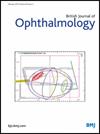Two-year outcomes of repeated red light therapy in premyopic children: sustained efficacy and rebound effects
IF 3.5
2区 医学
Q1 OPHTHALMOLOGY
引用次数: 0
Abstract
Background To evaluate the long-term prevention effectiveness and rebound effect of repeated red light therapy (RRLT) in children with premyopia over 2 years. Methods A total of 108 premyopic children (cycloplegia spherical equivalent refraction (SER): −0.50 to +0.75 D) were enrolled and followed for 24 months. Participants were randomly assigned to the RRLT or control groups. The RRLT was administered two times per day for 3 min per session, with at least 4-hour interval. At the beginning of the second year, participants receiving RRLT were further randomised into continued treatment and washout subgroups. Axial length (AL), SER and subfoveal choroidal thickness (SChT) were measured. Results Over 2 years, the RRLT group showed significantly smaller AL elongation (0.26 mm; 95% CI 0.18 to 0.35 mm) and SER progression (−0.21 D; 95% CI −0.35 to −0.08 D) compared with the controls (AL: 0.43 mm; 95% CI 0.36 to 0.49 mm; SER: −0.66 D; 95% CI −0.79 to −0.52 D). The RRLT group also demonstrated significantly less SChT thinning (−2.44 µm; 95% CI −16.11 to 11.23 µm) than the controls (−44.12 µm; 95% CI −53.05 to −35.19 µm). After RRLT cessation in the second year, the washout subgroup exhibited significantly faster AL elongation and more SChT thinning than the controls, with no significant difference in SER progression. Conclusions The 2-year RRLT intervention effectively retarded AL elongation and SER progression in premyopic children by 0.17 mm and −0.45 D, respectively. Notably, a significant rebound effect was observed in AL growth following 1-year RRLT cessation. Data are available upon reasonable request. The datasets generated/analyzed during the current study are available from the corresponding author on reasonable request.反复红光治疗近视儿童的两年结果:持续疗效和反弹效应
背景评价重复红光治疗(RRLT)对2岁以上儿童近视前期的长期预防效果及反弹效果。方法选取108例近视儿童(单眼截瘫球等效屈光(SER):−0.50 ~ +0.75 D),随访24个月。参与者被随机分配到RRLT组或对照组。RRLT每天两次,每次3分钟,间隔至少4小时。在第二年开始,接受RRLT的参与者进一步随机分为继续治疗组和洗脱组。测量轴向长度(AL)、SER和中央凹下脉络膜厚度(SChT)。结果2年后,与对照组(AL: 0.43 mm; 95% CI 0.36至0.49 mm; SER: - 0.66 D; 95% CI - 0.79至- 0.52 D)相比,RRLT组AL延长(0.26 mm; 95% CI 0.18至0.35 mm)和SER进展(- 0.21 D; 95% CI - 0.35至- 0.08 D)明显更小。RRLT组的SChT变薄(−2.44µm, 95% CI−16.11 ~ 11.23µm)也明显小于对照组(−44.12µm, 95% CI−53.05 ~−35.19µm)。在RRLT停药后的第二年,洗脱亚组表现出比对照组更快的AL延伸和更多的SChT变薄,SER进展无显著差异。结论2年RRLT干预有效延缓了近视前儿童AL伸长和SER进展,分别延缓了0.17 mm和- 0.45 D。值得注意的是,在停止RRLT 1年后,观察到AL生长的显著反弹效应。如有合理要求,可提供资料。本研究中生成/分析的数据集可应通讯作者的合理要求向其提供。
本文章由计算机程序翻译,如有差异,请以英文原文为准。
求助全文
约1分钟内获得全文
求助全文
来源期刊
CiteScore
10.30
自引率
2.40%
发文量
213
审稿时长
3-6 weeks
期刊介绍:
The British Journal of Ophthalmology (BJO) is an international peer-reviewed journal for ophthalmologists and visual science specialists. BJO publishes clinical investigations, clinical observations, and clinically relevant laboratory investigations related to ophthalmology. It also provides major reviews and also publishes manuscripts covering regional issues in a global context.

 求助内容:
求助内容: 应助结果提醒方式:
应助结果提醒方式:


